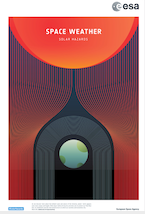Speaker
Description
The Service Oriented Spacecraft Magnetometer (SOSMAG) is a TRL-8 instrument that is suitable for use on satellites without magnetic cleanliness programme. Its development was initiated and conducted by the European Space Agency and the instrument was built by the SOSMAG consortium (Magson GmbH, TU Braunschweig, IWF Graz and Imperial College London).
SOSMAG enables detection of the spacecraft field AC variations on a proper time scale suitable to distinguish these variations from the magnetic field variations relevant to space weather phenomena, such as sudden increase in the interplanetary field, change of its direction or a magnetospheric boundary crossing. This is achieved through the use of two science grade fluxgate sensors on an approximately one meter long boom and two additional magneto-resistive sensors mounted within the spacecraft body, which are ideally located in the vicinity of dynamic magnetic field sources like e.g. reaction wheels and magnetic actuators. The measurements of the two spacecraft sensors together with the inner boom sensor enable an automated correction of the outer boom sensor measurement for the dynamic stray fields from the spacecraft.
SOSMAG has been deployed on GEO-KOMPSAT-2A (GK-2A), a South Korean meteorological and environmental satellite, which was launched to geostationary orbit (128.2° East) on December 4th, 2018. GK-2A is managed by the Korea Meteorological Administration and the Korea Aerospace Research Institute.
The SOSMAG instrument was commissioned successfully and has been delivering data since January 2nd, 2019. The raw data of the outboard sensor shows dynamic disturbances of 20 nT and a static offset of 10 to 90 nT. In a first approach, dynamic disturbances were attenuated using data from the additional sensors and static offsets were removed by comparison to the Tsyganenko T04 reference field model. The ongoing cleaning and calibration processing activities aim to achieve the accuracy requirements of ±5 nT for static and ±1 nT for dynamic fields.
With these promising results, SOSMAG can be considered as a “ready-to-use” solution that could be deployed as piggyback instrument on future long-term missions. One example could be, e.g., a geostationary satellite above European longitudes, which could bridge the measurement gap that is covered neither by GK-2A nor by the American GOES satellites.

